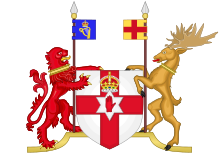Northern Ireland
Main article: History of Northern Ireland
As expected, the Houses of the Parliament of Northern Ireland resolved on 7 December 1922 (the day after the establishment of the Irish Free State) to make the following address to the King to exercise, within the one month allowed, the right to opt out of the Irish Free State: "Most Gracious Sovereign, We, your Majesty's most dutiful and loyal subjects, the Senators and Commons of Northern Ireland in Parliament assembled, having learnt of the passing of the Irish Free State Constitution Act 1922, being the Act of Parliament for the ratification of the Articles of Agreement for a Treaty between Great Britain and Ireland, do, by this humble Address, pray your Majesty that the powers of the Parliament and Government of the Irish Free State shall no longer extend to Northern Ireland".[29][30] Shortly afterwards, a commission was established to decide on the territorial boundaries between the Irish Free State and Northern Ireland. Owing to the outbreak of civil war in the Free State, the work of the commission was delayed until 1925. Leaders in Dublin expected a substantial reduction in the territory of Northern Ireland, with nationalist areas moving to the Free State. However the commission's report recommended only that some small portions of land should be ceded from Northern Ireland to the Free State and even that a small amount of land should be ceded from the Free State to Northern Ireland. To prevent argument, this report was suppressed and, in exchange for a waiver to the Free State's obligations to the UK's public debt and the dissolution of the Council of Ireland (sought by the Government of Northern Ireland), the initial six-county border was maintained with no changes.
In June 1940, to encourage the neutral Irish state to join with the Allies, British Prime Minister Winston Churchill indicated to the Taoiseach Éamon de Valera that the United Kingdom would push for Irish unity, but believing that Churchill could not deliver, de Valera declined the offer.[31] The British did not inform the Government of Northern Ireland that they had made the offer to the Dublin government, and De Valera's rejection was not publicised until 1970.
The Ireland Act 1949 gave the first legal guarantee that the region would not cease to be part of the United Kingdom without the consent of the Parliament of Northern Ireland.
The Troubles
Main article: The Troubles
The Troubles, starting in the late 1960s, consisted of about thirty years of recurring acts of intense violence between elements of Northern Ireland's nationalist community (principally Roman Catholic) and unionist community (principally Protestant) during which 3,254 people were killed.[32] The conflict was caused by the disputed status of Northern Ireland within the United Kingdom and the discrimination against the nationalist minority by the dominant unionist majority.[33] From 1967 to 1972 the Northern Ireland Civil Rights Association, modelling itself on the US civil rights movement, led a campaign of civil resistance to anti-Catholic discrimination in housing, employment, policing, and electoral procedures. The franchise for local government elections included only rate-payers and their spouses, and so excluded over a quarter of the electorate. The majority of disenfranchised electors were Protestant, but Catholics were over-represented since they were poorer and had more adults still living in the family home.[34]
NICRA's campaign, seen by most unionists as a republican front, and the violent reaction to it, proved to be a precursor to a more violent period.[35] As early as 1969, armed campaigns of paramilitary groups began, including the Provisional IRA campaign of 1969–1997 which was aimed at the end of British rule in Northern Ireland and the creation of a new "all-Ireland", "thirty-two county" Irish Republic, and the Ulster Volunteer Force, formed in 1966 in response to the perceived erosion of both the British character and unionist domination of Northern Ireland. The state security forces – the British Army and the police (the Royal Ulster Constabulary) – were also involved in the violence. The British government's point of view is that its forces were neutral in the conflict, trying to uphold law and order in Northern Ireland and the right of the people of Northern Ireland to democratic self-determination. Irish republicans regarded the state forces as "combatants" in the conflict, alleging collusion between the state forces and the loyalist paramilitaries as proof of this (loyalists are against the union of Ireland). The "Ballast" investigation by the Police Ombudsman has confirmed that British forces, and in particular the RUC, did collude with loyalist paramilitaries, were involved in murder, and did obstruct the course of justice when such claims had previously been investigated,[36] although the extent to which such collusion occurred is still hotly disputed.
As a consequence of the worsening security situation, autonomous regional government for Northern Ireland was suspended in 1972. Alongside the violence, there was a political deadlock between the major political parties in Northern Ireland, including those who condemned violence, over the future status of Northern Ireland and the form of government there should be within Northern Ireland. In 1973, Northern Ireland held a referendum to determine if it should remain in the United Kingdom, or be part of a united Ireland. The vote went heavily in favour (98.9%) of maintaining the status quo with approximately 57.5% of the total electorate voting in support, but only 1% of Catholics voted following a boycott organised by the Social Democratic and Labour Party (SDLP).[37]


No comments:
Post a Comment